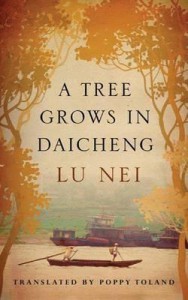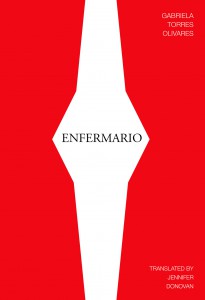
A Tree Grows in Daicheng by Lu Nei, translated by Poppy Toland, AmazonCrossing
Review by Christopher Chan, Chinese Social Media Intern
Whether a book can obtain certain currency among a wide range of readers depends upon its unique qualities. Take the genre of fantasy novels for example. Some books, like the Harry Potter series, do well because of the uniqueness of their ideas. Harry Potter was a fresh story about the wizarding world, told in an accessible language; others books, such as The Lord of the Rings, succeed with their sense of larger-than-life gravitas. A Tree Grows in Daicheng, however, is neither exclusively a book of fresh ideas nor of epic seriousness, but a careful mix of both.
The novel is a work of pastiche in many ways, especially through the narrative voices of different characters. The book’s uniqueness lies perhaps in its kaleidoscopic depiction of the great changes brought to a city called Daicheng and its people during China’s Cultural Revolution.
The book stands out for its linguistic creativity and humour. Many of us who were bored by dull descriptions in history textbooks will be struck by the writer’s use of vibrant language in portraying the Cultural Revolution playing out in Daicheng, a fairly tedious subject on the surface. With Lu Nei’s frequent use of metaphorical descriptions, readers are led to taste the dish of Daicheng’s history with some spice. For example, the protagonist of the novel is known as the Boy, his father is described as the bee and his dancing partners the flowers. The three people in the Boy’s family—the Boy, his sister, and his father—lead a life so tedious amidst the fast changing world that they are termed as three potatoes sitting in a pan of boiling water.
In another instance, the shaved head of Luo Jia’s father is compared to a big tangerine under the glare of the setting sun. The writer’s humour manifests itself most conspicuously while taking us through the action-packed city of Daicheng. We witness this at Long March Elementary School, when the Boy, moved by gentleness, almost loses control of his bladder; or when the Boy’s ear is twisted by his teacher Miss Ma until it takes the shape of a pretzel, exactly like that of the teacher’s face when she is livid. In this way, the characters often create a sense of comic relief against the novel’s serious historical background, and prompt readers to continue reading.
And yet, there is a strong sense of gravitas, even sadness, behind the apparent lightness. With careful depictions of the Boy’s hilarious appearance and experiences, readers are reminded of the fact that he is constantly bullied. The ebb and flow of events happening in Daicheng, even when funny, reveal how great political upheavals upend ordinary people’s lives, sometimes leaving them struggling to adapt.
These small details are better appreciated when pieced together to obtain a whole picture. All in all, Lu Nei succeeds in braiding the characters’ daily lives into the framework of a historical novel, priming readers to a crucial moment in Chinese history.
Bergeners by Tomas Espedal, translated by James Anderson, Seagull Books
Review by Cassie Lawrence, Executive Assistant
With Bergeners, I was coming to Espedal’s work completely fresh. Although he is a giant on the Norwegian literary scene, I, to my shame, had never read any of his work before.
Bergeners is an autobiography, depicting the aftermath of a breakup, whilst taking the reader on a journey from Norway to Berlin, via Greece, the United States, Albania, and more. It is certainly one of the more abstract autobiographies that I have read. The jumps between subjects and locations sometimes make it difficult to follow, yet the craftsmanship of the writing means that you can still appreciate the work.
The blurb refers to the book as a “love letter to the writer’s hometown [Bergen],” but the descriptions of glittery New York or peaceful Nafplio are much stronger—creating the impression that Bergen is a dreamlike place that can’t quite be pinned down. The feelings evoked by each of the locations in the book were definitely the highlights for me. Espedal writes about places and the emotions associated with each place so beautifully that I felt like I was physically with him throughout his journey.
The book is also a love letter to love. Espedal writes, “Love is one of the most beautiful things, but it can also destroy a person.” The journey from place to place is also a journey through the narrator’s pain and recovery following his breakup. Parts of the writing reminded me of Tanuj Solanki’s Neon Noon, and the comparisons are easy to see—the protagonist experiences a breakup out of the blue and feels compelled to leave the place where it happened in order to escape the memories of the relationship, both good and bad. Also, the self-conscious act of writing about being a writer, whether fictional or not, is something that occurs in both the books. The reflection is done well in Bergeners and did not jar with the reading experience, as can be the case with some books about writing.
Whilst reading Bergeners I kept forgetting that it was autobiographical. I suppose the mark of any good writing is to forget yourself momentarily. However, certain parts of the text slammed me with the recognition that these were actual moments in Espedal’s life, and the realisation made the book all the more interesting to read. One of these was Espedel’s recollection of his daughter’s hysterical phone call from Aker Brygge after the terrorist attack in Oslo in 2011. His astute assessment of the city centre following the attack is truly touching.
Some of the writing is a little heavy-handed and I did get lost, but the beauty of Espedal’s writing is that I didn’t particularly care. I wanted to follow his journey, whether it was clear or not. Could I tell you exactly what happened throughout the book? No. Would I recommend you to read and decipher it for yourself? Absolutely.

Enfermario by Gabriela Torres Olivares, translated by Jennifer Donovan. IN OTHER WORDS Translation Series, Book No. 3, Edited by Patrick Greaney, Les Figues Press
Review by Poupeh Missaghi, Editor-at-Large for Iran
Enfermario, the third book by Mexican writer Gabriela Torres Olivares, was published in Spanish in 2010 and named one of the best books of the year by Reforma newspaper. Now, it’s out in English in a bilingual volume by Les Figues Press.
Enfermario is a collection of fifteen stories, all of which deal, in one way or another, with the corporeal nature of life. The stories do not shy away from baring the human body and all that surrounds it. From the story of separated conjoined twins to that of a sister with impaired hearing; from diabetes to cancer, from masturbation to sex and rape, and from suicide to euthanasia and murder—the stories explore how the body falls by itself or is undone by those around it.
Olivares creates scenes that are immediate and harsh. She uses language that is direct, even vulgar, and exercises an honesty that bares the violence and vulnerabilities of her characters. She is not ashamed of exposing any aspect or layer of the human beings portrayed. For example, consider these lines from So What If She Has Tourette’s:
“The sound of a penis that enters and exits the virginal vagina of its daughter. The sound not of a rape by he who begot you. This is the sound of an agreement. The sound that will avert your roaming the streets in search of what your family gives you. This is the sound of education.”
Or these in The Parable of the Talk Show:
“He wishes that it had been him accusing the mother on national TV and getting all the prizes and tomorrow breathing a different oxygen, converting into different carbon dioxide. He would like to be the one who at the end of the program sobs and embraces the host, and when the credits roll: an audience applauding his great feat and sympathizing with his anguish. Hewisheshewereshe.”
The estrangement that Olivares’s characters feel, not just from those around them, but from themselves, is not just internal or philosophical, but, like their bodies, tangible and concrete. Not only does Olivares make the reader feel this estrangement but also makes us aware of our mortality and thus the complications of our existence as flesh and blood creatures. In “Skincubator” (fleshpot) we read:
“My mother knew. My mother sensed in her infantile and conspiratorial games that her sister Lola had caught something which occluded her hearing. For days she shouted at her; nevertheless she said nothing for fear… Altering them, mentioning it to her parents, would lead to a double punishment; for, in their home, messengers had their heads cut off too.”
The last story of Enfermario, “Autobiography of a Centaur,” has these lines:
“I went back to the neighborhood after much reflection. I didn’t have a reason to return, and nonetheless. I wanted to know the truth, not the true truth, rather, fate: that of my centaur.”
And that is perhaps the theme running through all the stories: this desire to know the fate of humans who, in one way or another, are all centaurs.
****
Read more reviews:

